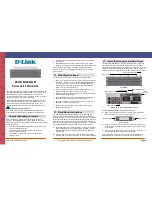
LHG-series
This manual covers LHG models:
(RBLHG-2nD)
(RBLHG-5nD)
(RBLHG-5HPnD)
Safety Warnings
Before you work on any equipment, be aware of the hazards involved with electrical circuitry, and be familiar with standard practices for preventing
accidents.
Ultimate disposal of this product should be handled according to all national laws and regulations.
All installation methods for mounting an access point on any wall surface is subject to the acceptance of local jurisdiction.
The Installation of the equipment must comply with local and national electrical codes.
This product is intended to be mounted outdoors on a pole. Please read the mounting instructions carefully before beginning installation. Failure to use the
correct hardware and configuration or to follow the correct procedures could result in a hazardous situation for people and damage to the system.
Use only the power supply and accessories approved by the manufacturer, and which can be found in the original packaging of this product.
Read the installation instructions before connecting the system to the power source.
We cannot guarantee that no accidents or damage will occur due to the improper use of the device. Please use this product with care and operate at your
own risk!
In the case of device failure, please disconnect it from power. The fastest way to do so is by unplugging the power plug from the power outlet.
It is the customer's responsibility to follow local country regulations, including operation within legal frequency channels, output power, cabling
requirements, and Dynamic Frequency Selection (DFS) requirements. All Mikrotik radio devices must be professionally installed.
The LHG is an outdoor wireless router with a built-in directional antenna. It can be used as a CPE or for point-to-point links (use RouterOS wireless mode
"bridge" to work as a single-client AP for point-to-point scenarios).
Exposure to Radio Frequency Radiation: This MikroTik equipment complies with the FCC, IC, and European Union radiation exposure limits set forth for an
uncontrolled environment. This MikroTik device should be installed and operated no closer than 20 centimeters from your body, occupational user, or the
general public.
Connecting
Open the Ethernet door to connect an Ethernet cable to the Ethernet port, connect the other end of the Ethernet cable to the included PoE injector.
Plug the PoE injector into your network switch or computer.
Plug the included power supply into the PoE injector to start up the device.
Download WinBox configuration tool
;
Default IP: 192.168.88.1, user name:
and there is no password, or use
admin
Neighbors tab and connect through MAC address;
Once connected configure the device, so it has an active Internet connection
Upgrade the RouterOS software to the latest version
;
Connect again and in the QuickSet menu choose your country, to apply country regulation settings;
Set up your router password in the bottom field to the right and repeat it, it will be used to log in next time.
The device is preconfigured as a wireless client and all you need to do is select the AP to connect to and set a device password. You can do this in the
QuickSet tab that is opened by default.
In case the IP connection is not available, Winbox can be used to connect to the MAC address of the device. In case you wish to boot the device from the
network, for example, to use MikroTik Netinstall, hold the RESET button of the device when starting it, until the LED light turns off, then the device will start
Assembly and Mounting



























